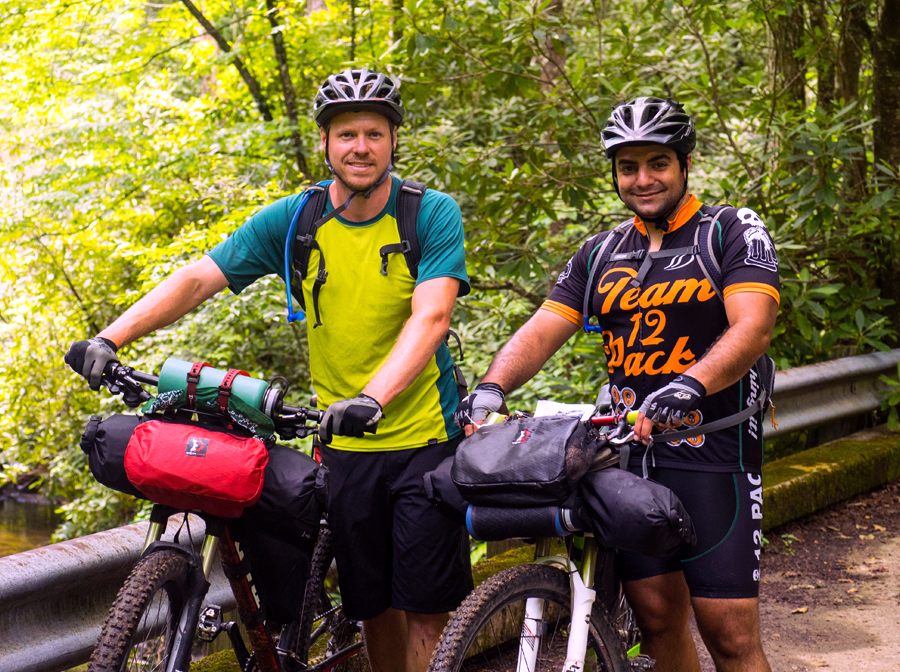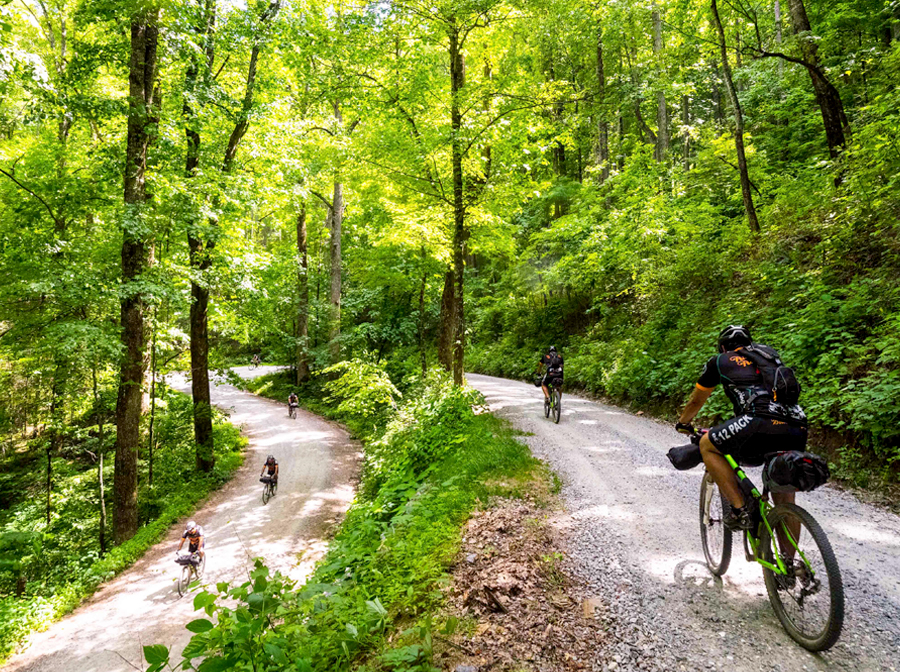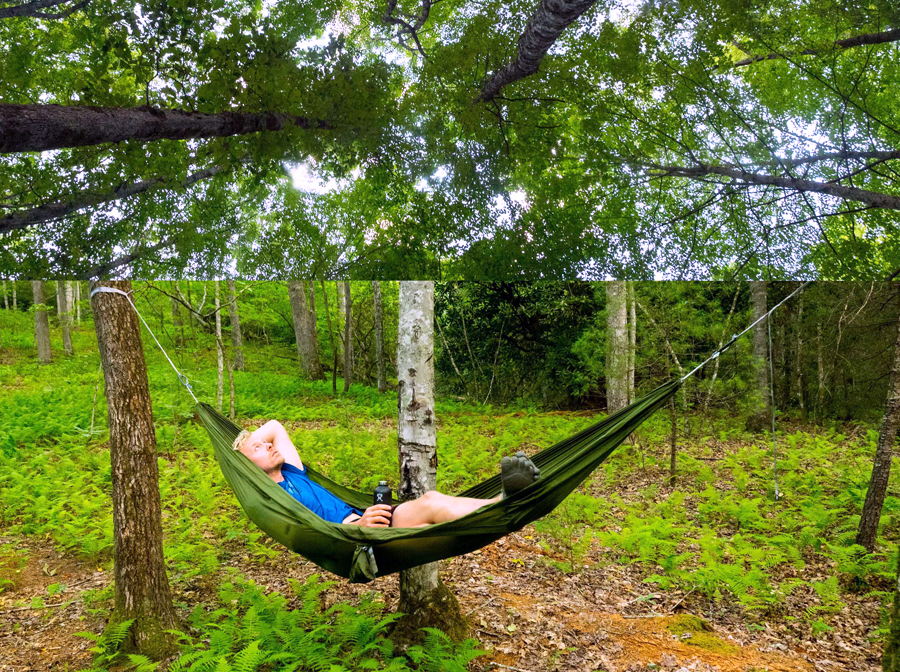Becoming Bikepackers on the Beer Trail
A mile out from Reeb Ranch, while ascending DuPont Road, I began to have doubts. Here we were on loaded mountain bikes, burning fresh legs up a paved highway with blind curves and little shoulder. We had knobby tires, new bikepacking bags, and enough snacks and fluids to stock a convenience store. If we broke down, we could raise cab fare by selling energy bars and electrolyte packets to underserved day riders.
I heard an engine whine and glanced back apprehensively. Just a few minutes before, on Crab Creek Road, we’d received a swervy message from a truck driver that our presence was not appreciated. Now a rapidly approaching SUV was slowing down, and a passenger was leaning out the window to offer a piece of his mind. Did we make an error in route selection?

This was our first bikepacking trip after five years of traditional touring with racks and panniers. But most of those trips were based out of my wife’s hometown in Baden-Württemberg on Germany’s extensive radweg network. Each summer, I combined family visits with rides — from a few days to a few weeks — through different regions of her country. My riding partner for plenty of these civilized jaunts was my buddy Boberts Hawaii, M.D. (a real doctor with a fake name I gave him in the tropics — long story). On our typical tour, we visited castles, breweries, and altstadts. We seldom found ourselves more than 30 minutes from a store. Somedays we ate schnitzel for lunch and dinner. We rarely wild camped; instead we pitched tents in established campgrounds with showers and restaurants. Our average day was 30 to 50 miles, but somedays we rolled an easy 10. We often joked that our biggest challenge was finding the next biergarten.
Essentially, when it comes to multiday cycling, I’m no hardcore mileage fiend — more of a roving rider, less concerned with daily distance requirements and more focused on collecting experiences. Indulging in the culture and landscape. Hopping off the bike for a photo or swim. Hiking up a nearby mountain. Exploring an old castle or cabin. Meeting new friends. And enabling it all with a bike — faster than walking but slower than driving — at a pace for appreciation. Thus, when Boberts and I decided to combine our passion for bike touring with our homegrown love of mountain biking, we knew we’d have to carry over some of this roving rider mindset to bikepacking. Sure, we couldn’t carry pork knuckles and a deep fryer on our hardtail 29ers. But at the very least, our first trip needed a brewery visit or two. This goal pointed us toward the region surrounding Pisgah National Forest and Asheville, North Carolina.
On DuPont Road, I braced for the verbal onslaught from the overtaking SUV. The passenger, in his 20s, hung his torso out the window, shook both arms, and hollered:
“You guys rock!”
That was not what I expected. He flashed two supportive hang-loose signs and gave a roaring southern whoop. Over the 20-minute climb, numerous cars passed. One driver honked and fist pumped. Another yelled, “Killer!” One dude slowed down to drawl, “Bad assss.”
The plan for our three-day route was simple. We’d start from Reeb Ranch, briefly dip into DuPont State Recreational Forest for a look-see, then pass through Brevard and into Pisgah National Forest. From there, we’d cross the Blue Ridge Parkway, ride the flowy singletrack of Bent Creek Experimental Forest, and end with a brewery tour of Asheville. Estimating the ride at 80 miles and 8,000 feet of climbing, we hoped this was a realistic shakedown. Luckily, there would be countless options to customize en route.
From the parking lot, we ascended Lake Imaging Road for a few miles before diverting onto the Hilltop Trail. With nearly 100 miles of shared trails, DuPont is a favorite mountain biking destination in the Southeast. The state of North Carolina acquired the 10,000-acre forest in stages from the DuPont company, beginning in 1995. Zipping happily along the smooth trail, I was surprised by how familiar my bike handled despite the extra 25 pounds of gear and bags. Heavier, sure, but still nimble and entertaining. Boberts and I agreed that if we weren’t careful, we’d blow our quads at the start. So we preserved energy by skipping the slick granite of Cedar Rock and favorite downhill, Ridgeline.
We left the singletrack and turned onto Buck Forest Road, passing through a picturesque covered bridge and stopping to admire High Falls tumbling beneath. We continued down the Triple Falls Trail, then walked to the lookout for the tiered waterfall made even more famous as a key filming location for the 2012 film The Hunger Games.
Speaking of hunger, we’d played a bit of chess regarding that topic ourselves. On our German cycling tours, we’d been spoiled by abundant restaurant and resupply options. It was like having a never-ending pannier full of goulash and dumplings. But the benefit of bikepacking seemed to be venturing away from the comforts of civilization. I was lucky to have relevant experience as a multiday kayaker and backpacker. But the weight and capacity limitations of bikepacking — smaller bags, rougher terrain, looser surfaces, and the inevitability of pushing — were more severe.
All corners of our bags were stuffed with calories: bars, powders, gels, jerkies, dried fruits, salamis, cheeses, and breads. Dinners and breakfasts were dehydrated meals. During one of our dozen planning calls, Boberts had remarked, with humor and frustration, “I’m just gonna eat nuts and berries.”
“Like a bear?” I’d joked. Then had a realization. “Shit. Will we need a bear bag?”
The answer, in the Appalachians during early June, is YES. So I had parachute cord stuffed somewhere too.
After a pleasant 15 miles across country roads to the town of Brevard, the next destination was Oskar Blues. On the patio, we washed down a few of our heavier stores — like hardboiled eggs and apples — with a pint each from our favorite Colorado-founded brewery. They opened the Brevard location in 2012. Two years later, they built Reeb Ranch for camping, cabin rentals, events, and mountain biking. We filled two insulated bottles for camp refreshments and resumed our ride.
At the entrance to Pisgah, we stopped at The Hub, a cycling shop and taphouse. Despite our extensive preparations with food, bikes, and equipment, the one thing we didn’t have was a good map. We’d planned the route mostly with online maps and MTB websites, saving images to our phones and printing pixelated pages. But as I scanned the map shelf, I found a perfect National Geographic waterproof fold-away map covering everything. Boberts and I were bent over studying topographic lines when I felt a presence looming.
“I saw you ride up,” said a young employee — with the shin scrapes and grimy fingernails of a serious rider — in a judgmental tone. “You look like you need some help.”
There are two places in the world where you pay a lot of money to have experts tell you you’re not good enough. One is college. The other is a bike shop.
As Boberts explained our objective, the rider eyed us suspiciously.
“Where are you from?”
I considered the snarkiest response I could muster. The ocean. We heard about this place called land and these things called wheels. Thought we’d see for ourselves.
Boberts answered, “Chattanooga.”
“Well,” observed the rider. “That’s better than I thought you were going to say.”
We listened to a long lecture about how hard the riding was in the area — by a local who had never left home. And we received proper instruction on what is and isn’t fun on a bikepacking trip — from a downhill rider who’d never bikepacked. And after the obligatory five minutes of insults, we learned several excellent items of helpful information. From these, we shortened one leg and moved two climbs to gravel roads from singletrack sections, but at the cost of losing a desired descent. And we were off.

After a few miles on Highway 276, we veered onto a gravel road. In the parking lot of the Avery Creek Horse Stables, we met a pair of day riders on full-suspension bikes. The two fellas were both Colombian, with Luis in town to visit Sal, who, like Boberts, was a doctor transplanted to the area. Luis looked pretty frazzled and decided to stop for the day. The shorter, fitter Sal explained they’d become lost and ridden way more than intended. Now Sal just wanted one final lap down Black Mountain. He was ascending in our direction, so we all took off on a five-mile, 1,500-foot gravel climb toward our first camp.
As we rode, Sal asked questions about our trip. “Two nights?” he said, incredulously studying the compact bikepacking bags. “Hope you have enough beer!”
I pointed at the Hydro Flask mounted to my handlebars like antlers on a truck grille. I’d been unsure this would work, but the trial at DuPont indicated success. A pair of ski straps kept the beer snugger than a rum keg on a St. Bernard’s collar in the Alps.
After riding and chatting for 20 minutes, Sal turned off toward his descent. But when I looked back, Boberts was out of sight. By the time he arrived, he seemed more frazzled than Luis.
“Phew,” gasped Boberts. “This hill is kicking my butt.”
I was surprised. Boberts lives in the foothills of the Appalachians and rides steep trails all the time. It was me I’d been worried about, having lived in St. Louis the past 10 years. Outside of traveling, most of my riding was in the nearby Ozarks, a hilly limestone region offering plenty of rides with frequent ridges and bottoms, but little sustained climbs. To get just 2,000 feet of gain, I’d been logging 40- to 60-mile rides a few times per week.
We stopped in the shade for food and water before continuing to Bennet Gap. From the trail junction, we pushed up some rooty stairs and rode the final mile to a three-sided shelter. Boberts was ecstatic about hanging his hammock inside the shelter, but the best bunk option for me looked more tetanus-with-a-side-of-spider-bite than it did Appalachian Trail adventure. Instead, I pitched my tent in the grass.

While Boberts built a fire, I tied a rock with parachute cord and hurled it into the canopy. As we lounged in hammocks drinking ice-cold brews, Boberts offered a confession. After 30 miles and 3,000 feet of climbing, he wasn’t sure he’d make it to Asheville.
“I only did two training rides,” he said sheepishly, then joked, “Want to just camp at the next brewery?”
“I’m going to ride it out,” I said.
Boberts shrugged. “I’ll do my best.”
After breakfast the next morning, we pumped water from a nearby spring and broke camp. From the junction, we headed west on the excellent Buckhorn Gap Trail. We zipped along smooth dirt singletrack, with the occasional loose cobble section, passing through fern forests and tree tunnels. Continuing onto South Mills Trail, we followed the idyllic river of the same name and stopped to explore the banks.
As we left South Mills, we reached our first major route change. Originally, we’d hoped to continue north on singletrack, including the iconic slate rock of Laurel Mountain. But out of caution for steeps, we instead took the scenic Yellow Gap Road. And if riding gravel is boring, then please just bore me the rest of my life, thanks.
The gravel road followed a pair of tumbling creeks before climbing to a densely forested saddle. While resting, a sedan with two mountain bikers and a cyclocross rider congregated inquisitively around our bikes, offering their respects. This latest jolt of encouragement invigorated a fatigued Boberts, and soon we were coasting downhill at top speed toward North Mills. At one time, we’d planned to ride pavement to the Sierra Nevada Brewery in Fletcher before camping in the Rec Area. But a 16-mile out-and-back evening gave Boberts that cyclist-in-headlights look.
After refilling water in the campground, some curious roadies invited us to their post-ride tailgate. At one roadie’s suggestion, we turned up a nearby gravel road headed for a quaint area known as Bad Fork. “It’s pretty far,” he said, eyeing the sun. “Might not make it.” But the map indicated three miles, and we reached the junction 40 minutes later. Adjacent to the road were some concrete slab campsites that Boberts was eyeing like meat slabs in a butcher shop. But I pontificated on high-minded notions of primitive camping — plus I had the beer — so Boberts begrudgingly followed me up the singletrack until we found a lovely campsite by Bad Fork Creek.
After building camp, I got to work on boiling water for dinner. Boberts approached me with an odd look.
“I think I got bit by a bug on my … on my … butt.”
“I’m no doctor,” I said, “but I think you have a saddle sore.”
“Never had one before,” he disagreed, shaking his head.
“I’m not looking at your butt.”
We stared at each other, a regular bikepacker standoff, until the water was boiling.
We opened our beers and toasted our final night, but I could tell that Boberts was feeling down. When our Mountain House meals were ready, he let his slip from his hand and spilled half his meal. He hung his head, and I urged him to drink water.
“This is harder than our old trips,” he said in a low voice.
“You just didn’t train enough,” I said. “You got this. Same as those. Just need to ride more beforehand.”
“I’m not sure this sport is for me.”
I was shocked. This was so very un-Boberts-like. The man usually felt he could do anything. We’d hiked mountains and paddled rivers and ridden in the Alps. While the rest of us were stumbling our way through college, he studied late into the night and swung by the parties once finished. “I just don’t have enough time to ride anymore,” he continued dejectedly. “And even when I did ride a lot, I was never as fast as Cole or as strong as Twiz.” Boberts’s shoulders slumped.
“What about night riding?” I said. “Can you do that after work?”
Boberts shrugged. “Yeah, maybe.”
“Dude, you got me into this sport. Remember? Took me out that first time to Salmon Falls.” I stood up on a rock, like I imagined the mayor of mountain biking would. “Who cares how fast you are? We might be two of the slowest riders that ever rode bikes.”
This was the crux of our trip, the moment when we either became bikepackers on the beer trail to Asheville or gave it up before we started. Called for a pick-up. Boxed it all in the garage. Wrote off the new gear as failed experimentation.
The next day, we skipped the gravel and rode and pushed our bikes up Bad Fork Trail, just because we could. We rode the Blue Ridge Parkway for a few miles (yes, the wrong way, but we caught the error), then dropped into Bent Creek Experimental Forest. The only forestry research we conducted was how fast we could ride flowy singletrack on loaded mountain bikes. The answer was fast. Then we rode surface roads to Asheville, where Boberts’s med school buddies joined us. After a brief checkup, they pronounced him medically sound and we took our celebratory brewery tour.
It was just a three-day trip, but it felt like a week of fun.
Yet before all that could happen, in the campsite on Bad Fork, I needed to finish my speech. I walked over to my bike and pulled out two items I’d saved for a final day celebration at the bottom of Bent Creek: a small flask of tequila and a fresh chub of dry salami.
I considered the cheesiest line I could muster. Take two of these and call me in the morning.
Instead, I handed them over and said, “Save me a little.”
“Pshh,” Boberts scoffed. He took a swig and passed it back. Then he laughed straight out of the old days.
“Next time we go bikepacking, you better bring a bigger bottle.”


